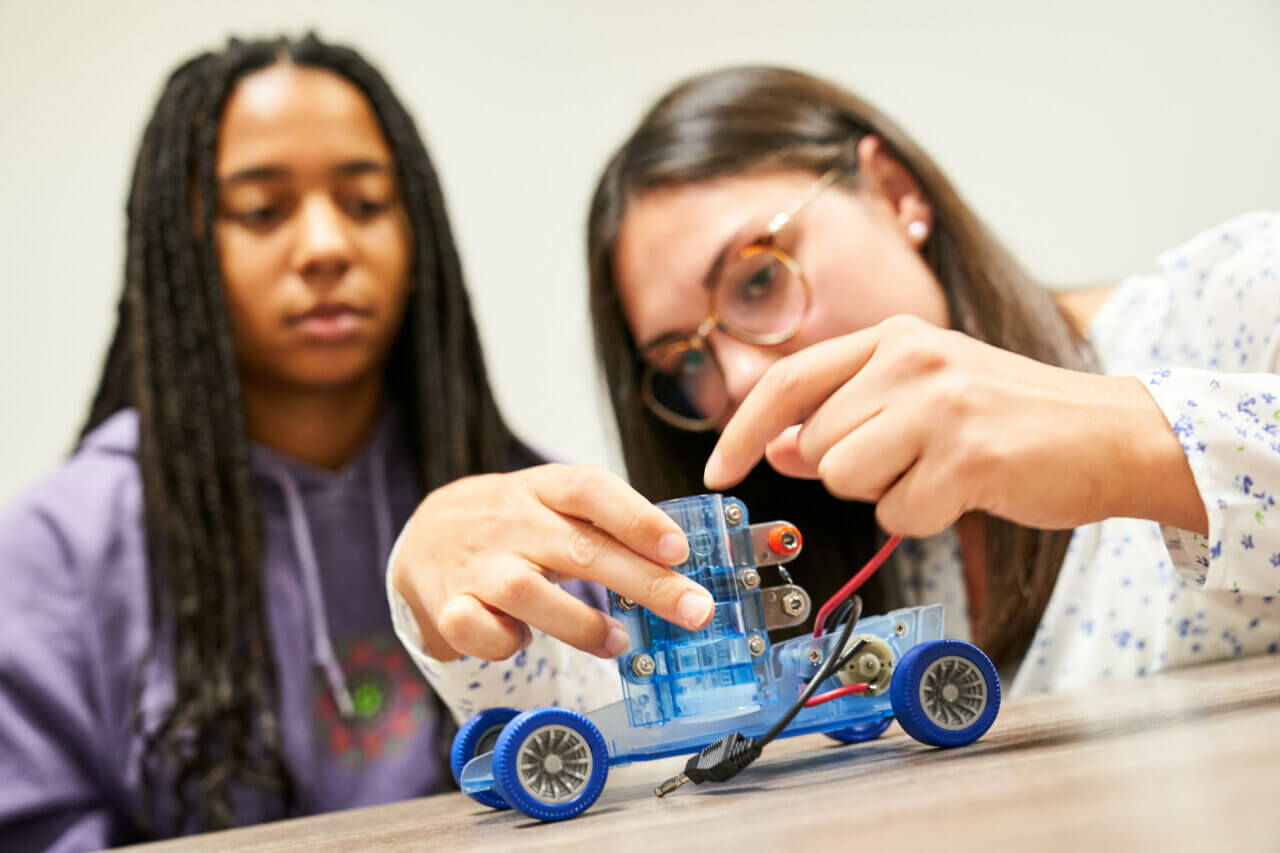Initiatives such as NAT, mint:pink, ProTechnicale and others are intended to get students excited about (natural) scientific and technical topics. Thanks to committed colleagues, ZAL is a strong supporter of these programs, namely when engineers and researchers at ZAL take the time to talk and give hands-on introductions to their favorite topics.
mint:pink at ZAL (Text: Deike Uhtenwoldt, Photo: Claudia Höhne – both Initiative NAT)
Easy is different, Mara has to crank quite a bit. “Shall I try?” asks Chiara and takes over the miniature car. The two St. Ansgar students are currently on a complex physical-chemical mission at ZAL: The 15-year-olds produce hydrogen using a fuel cell as an electrolyzer. The more energy they supply via the crank, the more the water level in the tank drops – twice as fast for hydrogen as for oxygen. Why? Chiara thinks for a moment: “H 2 O,” she finally refers to the water reaction equation. When it’s full, the miniature car can make it across three tables placed one behind the other about ten times. Is this the solution to the energy crisis being researched at ZAL?
High-flying
Sebastian Altmann, the host of this mint:pink program day, has long been a believer in the lightest element in the periodic table. He did his dissertation on fuel cells, studied aerospace engineering and joined ZAL when it was still considered a start-up. In the meantime, the start-ups tend to come to the large new building in Finkenwerder to present their ideas to players such as Airbus, DB Schenker and Lufthansa Technik. The girls are impressed that so many different companies and supposed competitors are working together in the center. They are also inspired and connected by research into the most volatile of all elements: “Hydrogen is a wonderful energy carrier; we have an incredible amount of energy per kilogram and could produce an infinite amount of it,” Altmann enthuses.
Far-reaching
However, the small experimental setup that the energy engineer prepared for the schoolgirls also highlights the challenges: the girls produced just one gram of hydrogen using a hand crank and a fuel cell. “To run a car 100 kilometers, you need one kilo,” Altmann says. This would require an eleven cubic meter tank cube because of the low gas density – definitely too much for a car. The schoolgirls learn about one possible solution on their tour of the Tech Center: A slim tank 20 meters high holds together 350 kilograms of hydrogen at 45 bar for experimentation on low-emission flying. “You could drive all the way to Cape Town and back with that. It’s just a bit silly to attach the tank to the passenger car,” jokes Altmann.
Futuristic
No kidding, his team is currently working on a drone that could fly for about eight hours on liquid hydrogen, ten times as long as a battery-powered aircraft. And thus in demand by operators of offshore wind farms, pipelines or in forest firefighting, Altmann says: “There’s an interest in long-flying drones.” The girls prove especially interested in the large airport-look factory floors, labs and conference rooms. “This is so cool,” Chiara enthuses, proving a green glowing square to the right of the “Pitch B-1-109” group room – it’s the door opener. Victoria is thrilled by the airplane parts standing around and her twin sister Katharina by the practical research on them: “You could tell they’re having fun working together and seeing progress.” And in one of Katharina’s favorite subjects – the chemistry is right!





